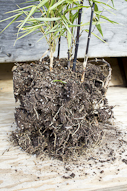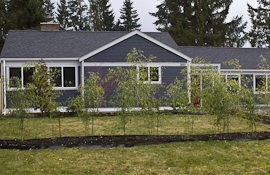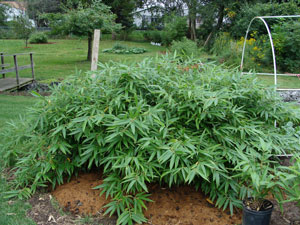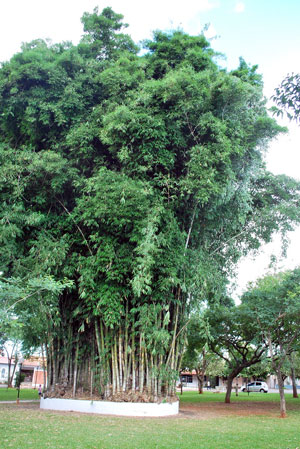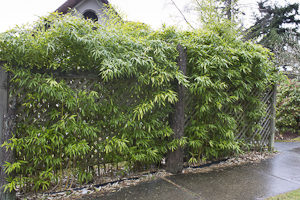Installation:
Relatively little soil preparation is necessary before planting bamboo. Bamboo will thrive in almost any soil type, from clay to sand. If you want, you can work in a little manure or compost. Bamboo loves nitrogen like all grasses. Remember, bamboo is a surface plant: it will stay for many years in the top foot of whatever you plant it in. I have successfully grown Decora on solid rock by simply surrounding the root balls with a couple of bags of composted steer manure. Eventually mature groves will have two feet or more of subsurface root structure, but a good deal of this develops in layers of composted bamboo leaves dropped over many seasons on top of the original soil surface.
When you first take the bamboo plant out of its container, you have a decision to make. Bamboo suffers greatly from ‘pot memory.’ If you want your bamboo to spread out rapidly and begin to fill in a larger area, then you must cut away or straighten out all of the roots and rhizomes which are curling around the inside of the pot, including the bottom of the root ball. This is tough to do, but necessary. Use a reciprocating saw, a handsaw, a machete, or a hatchet, and be brutal -- shave off a half inch or more everywhere. On the other hand, if control is a primary concern, then by all means plant everything just as it comes out of the pot. It will take several years for the bamboo to realize that the pot is no longer there.
Plant the top of the root ball even with the surface of the soil. Bamboo is a surface plant. Avoid competition from other grasses.
For hedge installations, I recommend planting at three-foot intervals for a continuous screen in three years, or five-foot intervals if you can wait another year. Larger root balls planted tightly together can produce instant privacy.
Control techniques:
Almost all of the large spreading bamboos grown in the Pacific NW belong to the genus Phyllostachys. Phyllostachys bamboos, in this climate, want to be a grove about 30 to 50 feet in diameter. Once they achieve this size, they settle down and stay put – sort of. If you have the room, such a grove can be thinned to achieve a walkable forest of mature bamboo – individual canes, often several inches in diameter, a couple of feet apart, coming up through a deep, soft, uniform duff of golden leaves. Hollow it out and put in a hot tub or teahouse.
For most of us however, some sort of control of this natural grove size is necessary, and fortunately, easily achievable.
I recommend planting bamboo on top of the original soil surface. Bamboo hates to grow downhill. Often the only control method needed is to plant bamboo along the top of a two-foot high mound of soil at least three feet wide and as long as you want the bamboo grove or hedge to be. Run a drip line down the center of the mound between the plants, and the new growth will follow the water like magic. Specimen bamboo plantings look especially good on top of a circular mound. Eventually, once the bamboo has filled in the top of the mound, the occasional rhizome may try to escape down the hill. When it does, the rhizome growing tip will break through the surface of the side of the mound before making a sharp turn down to get back below the surface. This will leave a sharp hook of rhizome visible above ground, which then can be easily cut with a lopper. By this time, the hill will be covered in a fine mulch of fallen bamboo leaves and the occasional rhizome will stand out like a sore thumb. That’s all you have to do, just cut any visible hooks of rhizome on the sides of the mound once each winter. First year rhizomes are not viable once they are detached from the mother plant.
Even better control can be achieved by getting the dirt used for the mound from a sheer walled trench dug around the base of the mound, or along one side. However this is getting pretty serious and often is not necessary. It can usually be put off awhile.
Green fence utilizing barrier

Ancient bamboo grove turn of the century Ceylon
 Black bamboo in a Japanese temple
Black bamboo in a Japanese temple
Barrier:
For most applications, the need to totally control the growth of bamboo can be postponed for many years, if not indefinitely, by easy annual maintenance (see Care). However, when complete and permanent control is necessary, barrier material is the only way.
If you are spending big money to install a barrier then it makes sense to do it right. Almost no one does because it’s a bit more work and maybe a little more money for fasteners. Here is how, after long experience, I have learned to install a relatively foolproof barrier system.
Start with the real thing, HDPE 60 mil, at least 30 inches deep. Get 4 feet more barrier material than the rectangular circumference of the area to be contained. Rectangular because we must have at least four corners in order to correctly lean the barrier away from the plant in all directions. It is imperative that all rhizomes, when they encounter the barrier, are turned up, not down. If any part of the installed barrier is not sloped away from the rhizome, then the rhizome may well turn down and will simply go under the bottom and escape. Unfortunately, this can happen, especially with large bamboos and relatively shallow barriers.

Make the four sides. Cut each piece one foot longer than the finished size of the bed. Mark 4 inches back from each bottom corner, scribe and cut the angle.
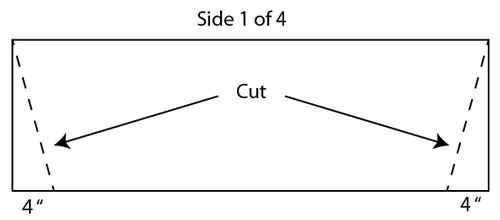
The other common failure with bamboo barrier is the joint. No amount of overlapping of the material helps, bamboo rhizomes will smash themselves flat as a credit card and force their way into a tight crack for many feet, slowly denting their way through; they’re good at it. The only sure way to prevent this is to face the cut edges back into the plant area and then seal them together top to bottom with two pieces of stainless steel strapping at least ¼ inch by one inch and with a ¼ inch SS bolt every inch or two. (Predrilled SS straps are available at steel supply houses.) Be sure to trim the barrier material flush with the straps after you have bolted them together, so as not to lead any rhizomes into this crack. With the joint pointed into the plant, this should pass the test of time.
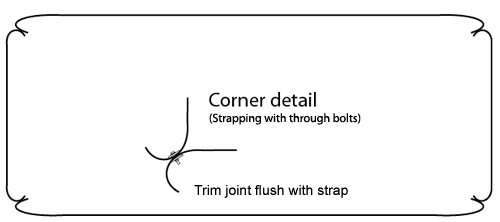
The upper edge of the barrier should be installed at least 6 inches above grade. Even so, some of the upturned rhizomes will manage to hook down over the top of the barrier and be off for greener pastures. These make themselves obvious and can easily be cut off each winter. To avoid this, we need to block the rhizomes at the top of the barrier. I suggest a 2x2” piece of wood or aluminum angle, bolted to the top inside edge of the barrier material. An elegant look can be easily achieved by through- bolting this inner piece to a weather resistant 2x6 frame on the outside.
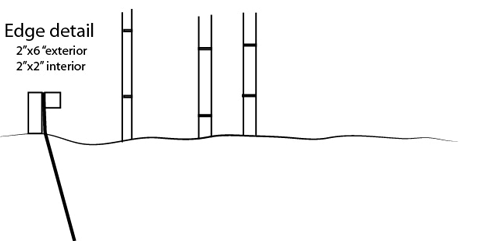
.

